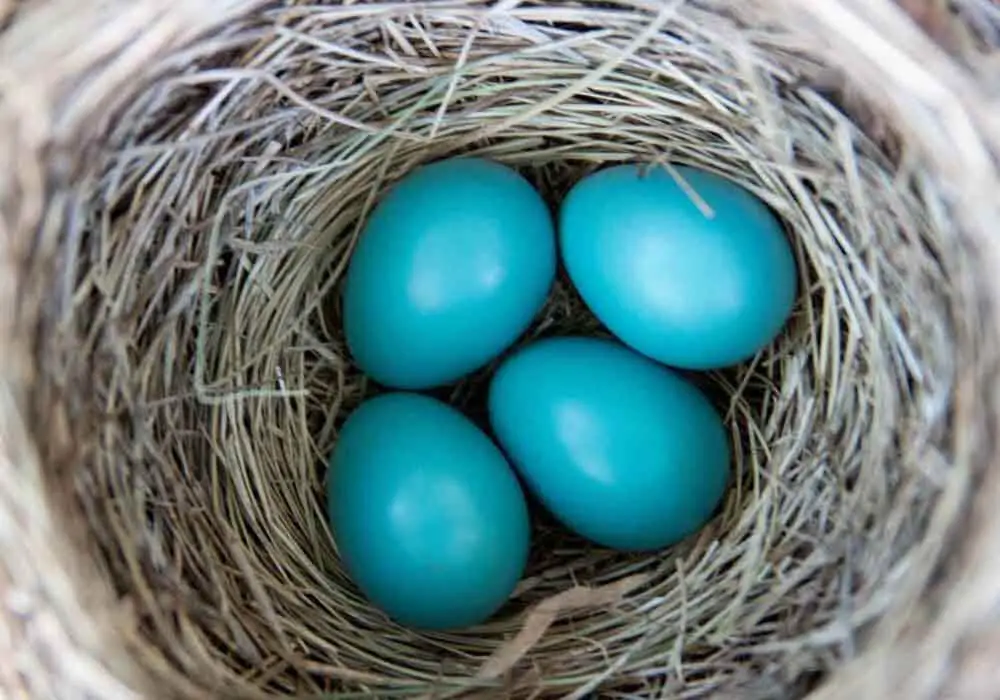Bluebird Egg Facts
From Cute Chick to Beautiful Bird!
The bluebird is a medium-sized North American species known for its vibrant blue plumage. This little creature is commonly found in the open country, and you're sure to spot them near fields, meadows, and, if you're lucky, in your backyard. They're known to make homes in comfortable backyards where they can lay eggs and raise their young. Here's a few more Bluebird egg facts...
Bluebirds lay between two and seven eggs every season and are known to parent between one and three broods every season. Bluebird eggs are typically pale blue and sometimes white in color, and the birds incubate these eggs for at least three weeks before they hatch.
In this article, I'll closely examine a few facts about bluebird eggs, so you're better prepared if one of these creatures decides to build a home in your backyard. Let’s get started!

How Often Do Bluebirds Lay Eggs?
If you have a bluebird in your backyard, it's best to learn how often they lay eggs. Keeping track of this cycle allows you to clean your birdhouse at appropriate times and create a safe space for the birds.
Bluebirds lay eggs between one and three times every season, with some even laying four to five times a year. The number of times this bird lays eggs will depend on its nesting site and how safe the birds feel about raising their young in this space.
As mentioned, bluebirds nurse between one and three broods every season and are thought to lay up to seven eggs in a single brood. However, remember that appropriate nesting conditions are vital in the egg-laying process.
Do Bluebirds Leave Their Eggs Unattended?
Many birds are known to leave their nests to forage for food periodically. However, in most instances, one of the parents will stay back in the nest to watch over the eggs. This isn't always the case with bluebirds.
Bluebirds will leave their eggs unattended for brief periods until the entire brood of eggs has been laid. Once all the eggs are laid in the nest, the actual incubation begins, where the parents ensure at least one of them is warming the eggs at any given point.
Sometimes, the female bird builds the nest alone and lays the eggs. The male will sit on these eggs for brief periods while she's out searching for food but will never incubate the eggs. This is the female’s job, and it begins when all the eggs have been laid.

Before Bluebirds lay their eggs, the whole nesting process must take place. In this fascinating article of ours we discuss nesting times, durations, bird behaviors and more. Learn all about the nesting habits of Bluebirds.
How Long Do Bluebirds Sit on Their Eggs Each Day?
The incubation period differs depending on the climate in which the nest is built. However, no matter what the environment, the female bluebird spends most of her time sitting on the eggs.
Female bluebirds sit on their eggs for almost the entire day, only taking breaks to eat and defecate. During this time, the female won’t forage for food, and the male bird will bring food to the nest.
Females spend so much time on the eggs because even the slightest chill can seep into the egg and damage the developing embryo. As such, most bluebirds spend as much time as possible sitting on their brood.
How Long for Bluebird Eggs To Hatch?
As mentioned above, incubation typically lasts about three weeks, give or take a few days, depending on the climate. However, unlike chicken eggs, bluebird eggs won't take longer than three weeks to hatch.
Bluebird eggs take between twelve and twenty days to hatch, depending on temperatures in the area. On average, eggs will take roughly thirteen days to hatch and may take longer if the female decides to take more breaks in between to eat.
It's interesting to note that although bluebirds take a few days to lay the eggs in a single brood, all the eggs hatch within 24 hours.
Ever see a Bluebird hatch?...So Cute!
What Do Bluebird Eggs Look Like?
Unlike the eggs we are used to seeing for breakfast, bluebird eggs have a slightly different color palette.
A bluebird egg is a tiny, oval-shaped object, typically light or azure blue. In some cases, a bluebird may lay white eggs instead of blue ones. If this is the case, all eggs in that brood will end up being the same color.
Bluebird eggs are pretty easy to distinguish from other eggs and are also a treat to look at.
What Is the Size of a Bluebird Egg?
As mentioned, bluebird eggs are tiny, and you must be extremely careful if you ever need to handle one.
A bluebird egg is typically between 0.7 and 0.9 inches (1.8 and 2.3cm) long and 0.6 to 0.8 inches (1.5 and 2cm) wide. Most eggs in a bluebird nest will be of this size. Smaller eggs may indicate underdevelopment and may not hatch when the incubation period is over.

Once eggs hatch, the chick goes thru growth stages that takes them from being a cute chick, to being a beautiful bird. In this article of ours, follow this amazing transformation of these Bluebird growth stages.
Do Bluebirds Abandon Their Eggs?
Birds will occasionally abandon their laid eggs. While this may seem heartless to us humans, birds often have solid reasons for doing so.
Bluebirds will abandon their eggs only in extreme circumstances. Examples include not being able to find adequate food or shelter. These birds will also leave their eggs if their partner dies during a crucial part of the hatching season.
Bluebirds are insectivorous and feed extensively on caterpillars, mollusks, and insect larvae. However, very low temperatures can make it challenging for them to find food as insects typically move around less in cold weather. In some cases, the birds may abandon the eggs hoping to find better feeding spots.
Additionally, a bluebird might abandon their eggs if the mate has died. For example, if the female dies during incubation, the male may leave the nest as incubation isn't a part of their role. Similarly, if the male dies during the egg-laying period, the female may choose to abandon the eggs she's laid for lack of support. bluebird egg facts
However, if one partner dies when the fledglings are very young, the other parent may continue to feed and raise the young.
How To Tell if a Bluebird Egg Is Still Alive?
Sometimes, you may be left with an abandoned nest and a whole brood of eggs to care for. So, how can you tell if the eggs are still safe?
You can tell if a bluebird egg is still alive by its external appearance. A live egg has a glossy appearance, a telltale sign that oxygen and CO2 exchange is still taking place. Dead eggs will lose the shiny shell and will feel lighter.
Another method of determining if a bluebird egg is alive is to run a flashlight over it in a dark place. If you can see veins through the shell and a reddish glow, it’s likely that the egg is alive.
If you find a brood of eggs, avoid touching them for a few days in case the parents decide to return. Even if the parents don't return, another female bluebird may visit the nest and adopt the brood for herself. While the eggs weren't laid by her, she will begin to incubate them, feed and rear the chicks as if they were her own.

Before you fly away, be sure to stay perched long enough to visit this other page on our site which shares all sorts of interesting and fun facts about birds eggs.
Bluebird Egg Facts...Final Thoughts
These are a few facts about bluebird eggs you may want to keep in mind if one of these birds decides to build a home in your backyard. Whatever happens, avoid disturbing the nest unless you're sure it's been abandoned, as this could dissuade the parents from ever returning.
Back To The TOP Of This Bluebird Egg Facts Page

About the Author...
Richard Worden, a dedicated bird lover for over 20 years, I love to share my in-depth knowledge and passion for birds. Read more About Me and my expertise in this field.
- We Know Birds HOME ›
- Bluebird Facts and Information ›
- Bluebird Egg Facts
